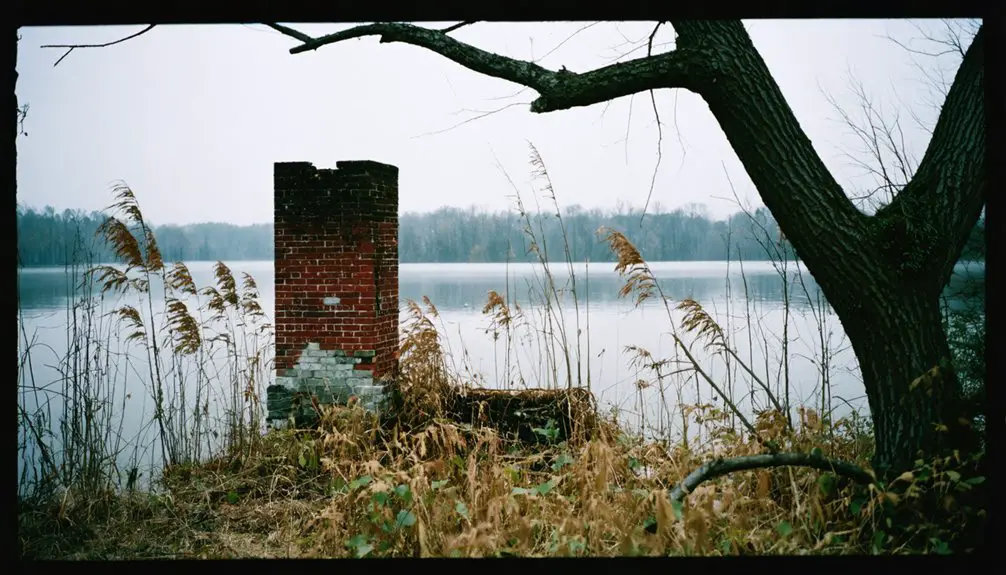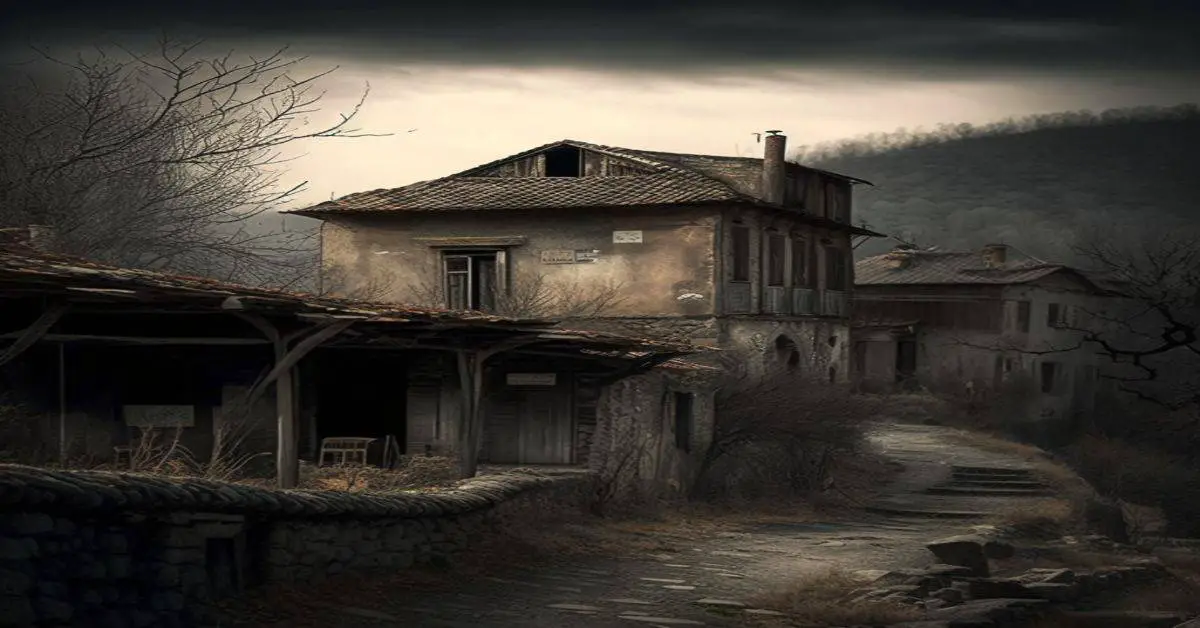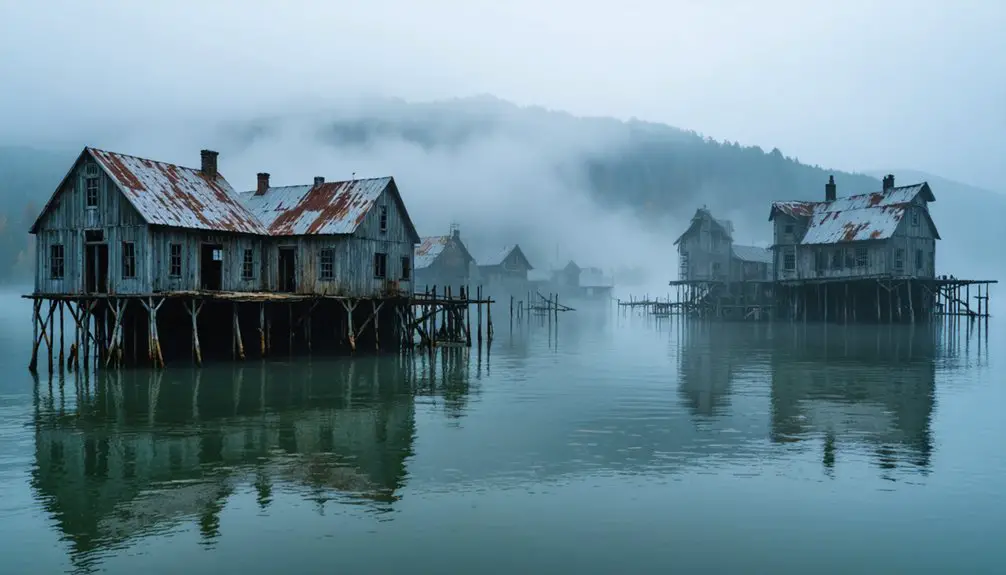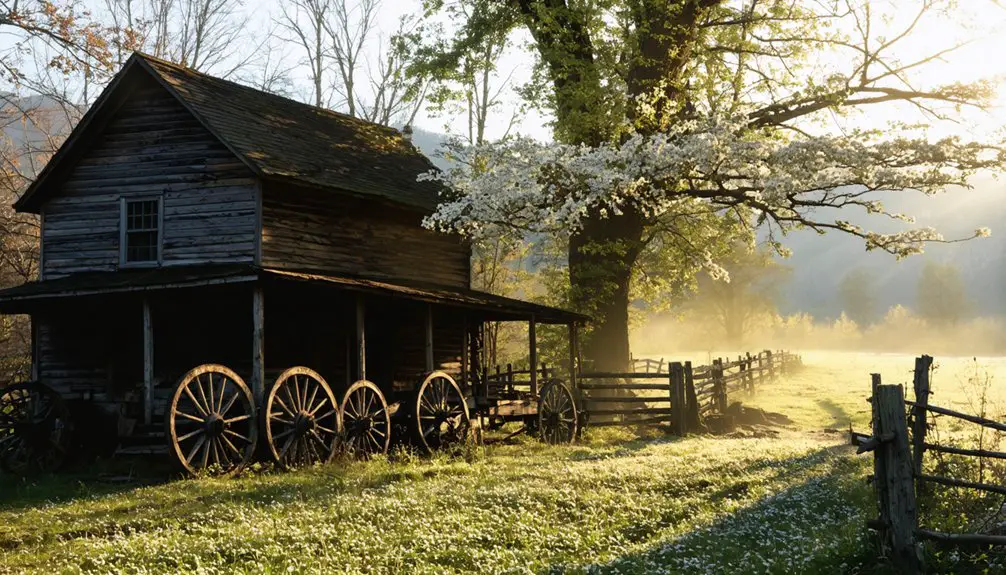You’ll find Rhea Springs, Tennessee beneath Watts Bar Lake today, but before 1940, it was a bustling health resort centered around sulfur-rich mineral springs. The town drew thousands seeking healing waters for ailments like liver disease and yellow fever. When the Tennessee Valley Authority built Watts Bar Dam, they displaced 800 families and submerged the town. At low water levels, you can still spot remnants of the grand hotel, church, and schoolhouse that tell a deeper story.
Key Takeaways
- Rhea Springs was a thriving health resort town in Tennessee centered around healing mineral springs before being submerged by TVA’s Watts Bar Lake.
- The town’s displacement began in 1936 when TVA acquired land for the Watts Bar Dam project, forcing nearly 800 families to relocate.
- Remnants of the ghost town, including hotel foundations and a water tower base, become visible during low water levels.
- The community featured a grand hotel, Methodist church, post office, and school before its submergence beneath Watts Bar Lake.
- A memorial in Spring City contains marble and granite from original buildings, while the old cemetery remains above water level.
The Rise of a Healing Haven
Before taking its name as Rhea Springs in 1878, this Tennessee community first emerged as “Sulphur Springs,” centered around a mineral spring that would shape its destiny as a renowned healing destination.
Indigenous beliefs celebrated the spring’s powerful healing properties, drawing early visitors who sought natural cures for their ailments.
Ancient wisdom recognized these sacred waters as medicine, beckoning those in search of the spring’s natural healing touch.
You’ll find the spring’s reputation grew dramatically during the 1878 yellow fever epidemic, when Chattanooga residents fled to the area seeking refuge.
The waters were especially praised for treating liver, stomach, and kidney diseases, making the site a crucial part of Tennessee’s thriving mineral spring resort culture.
As word spread of the spring’s therapeutic benefits, a vibrant community sprouted around it, complete with a church, school, post office, and homes serving both residents and health-seeking visitors. The destination grew to include a large hotel and seventeen small houses that accommodated the steady stream of visitors.
The town’s development included saloons and shops that catered to both locals and tourists seeking the spring’s healing waters.
Life at the Mineral Springs Resort
You’d find yourself among countless health-seekers at Rhea Springs Resort, where the sulfur-rich mineral waters promised relief from liver, stomach, and kidney ailments.
The resort’s lavish hotel welcomed guests for extended stays, offering a luxurious base for your therapeutic routines and social gatherings. The vibrant community life featured regular social events where families would gather at the hotel grounds. Visitors could enjoy amenities including harness shops and saloons during their stay.
During the 1878 yellow fever epidemic, you’d join the many Americans who fled to Rhea Springs, trusting in the waters’ protective and healing properties.
Healing Waters Draw Visitors
The healing waters of Rhea Springs drew hundreds of visitors from across the United States during the late 19th and early 20th centuries, transforming a modest sulfur spring into a thriving health resort.
You’d find visitors seeking the spring’s legendary healing properties, many staying for weeks to drink and bathe in the mineral-rich waters. The spring’s reputation for curing liver, stomach, and kidney ailments attracted those desperate for relief, especially during epidemics like the 1878 yellow fever outbreak in Chattanooga.
Your visitor experience would’ve included more than just health treatments. You could participate in lively dances and social gatherings while benefiting from the natural therapies that aligned with popular 19th-century American and European spa traditions.
Resort’s Luxurious Hotel Life
Life at Rhea Springs’ grand hotel offered guests a complete therapeutic experience, combining luxurious accommodations with health-focused amenities. You’d find yourself immersed in a vibrant social atmosphere where health-seeking merged with leisure activities.
- Elegant rooms furnished to late 19th-century standards catered to diverse social standings.
- Communal dining halls hosted regular social gatherings and events.
- Therapeutic mineral baths and specialized treatment facilities provided healing experiences.
- Staff members, including health attendants, guaranteed personalized care.
- Church services and community activities fostered meaningful connections.
The hotel’s luxurious amenities supported extended stays while you pursued wellness through mineral water therapies.
Whether escaping yellow fever or seeking relief from various ailments, you’d join others in a community atmosphere that balanced medical treatments with social interaction.
The resort’s prominence ended when Watts Bar Dam flooded the area in 1941, submerging this once-cherished destination beneath the waters.
A Thriving Community Born From Water
You’ll find the origins of Rhea Springs in its mineral-rich waters, which indigenous peoples first recognized for their healing properties before the site became known as Sulphur Springs prior to 1878.
The spring’s reputation as a “fountain of health” drew visitors from across the South seeking cures for liver, kidney, and stomach ailments, transforming the site into a bustling resort destination.
What began as a single therapeutic spring grew into a complete community with a grand hotel, Methodist church, schoolhouse, post office, and dozens of homes by the 1930s. The once-thriving community now lies beneath the waters of Watts Bar Lake, created through TVA’s dam construction program.
Healing Waters Draw Visitors
Known originally as Sulphur Springs until 1878, Rhea Springs earned its reputation from sulfur-rich mineral waters that drew visitors seeking natural remedies for various ailments. The “fountain of health” attracted people from across the region who believed in its curative powers, particularly for liver, kidney, and stomach problems.
- Native Americans, including Cherokee, first recognized the spring’s healing qualities.
- Visitors practiced both drinking and bathing in the mineral-rich waters.
- During the 1878 yellow fever epidemic, many fled to the springs for protection.
- Local testimonials reinforced the springs’ reputation as a healing destination.
- The waters’ therapeutic reputation helped establish Rhea Springs as a notable East Tennessee resort.
Your healing practices at Rhea Springs would’ve followed time-honored traditions of natural medicine, reflecting the era’s belief in mineral waters’ curative properties.
Resort Life Takes Root
During the late 19th century, Rhea Springs blossomed into a thriving resort community, transforming from a simple mineral spring into an elegant retreat destination.
You’d find a vibrant resort culture centered around a grand hotel, with nearby homes, a post office, schoolhouse, and church supporting the seasonal influx of visitors.
The social dynamics reflected the era’s elite leisure pursuits. You could spend your days taking in the therapeutic waters, socializing on sweeping verandahs, or attending evening dances in landscaped gardens.
The close-knit community fostered deep connections between guests and locals, who worked together to create an idyllic escape in the scenic Piney River valley.
Despite lacking railroad access, the resort’s reputation drew visitors from across America, seeking both healing and refined companionship in this Appalachian haven.
The TVA Decision That Changed Everything
When the Tennessee Valley Authority began acquiring land in the 1930s for its ambitious dam project, the fate of Rhea Springs was permanently sealed.
The TVA decisions reshaped not just the landscape but the lives of nearly 800 families who’d called this thriving community home. You would’ve witnessed a methodical community displacement as TVA letters arrived on August 1, 1936, signaling the end of an era. Construction of the Watts Bar Dam began in 1939, marking the physical transformation of the region. The completion of the dam in January 1942 supported crucial wartime efforts and atomic research.
- Your beloved mineral springs resort would disappear beneath Watts Bar Lake
- The church, school, and post office would be submerged forever
- TVA’s flood control and hydroelectric plans took priority over preservation
- Families like the Reeds and Ingles had to abandon generations of history
- The transformation traded local heritage for regional modernization
Today, Rhea Springs Park stands as a memorial to what you’ve lost, overlooking waters that hide a once-vibrant community.
Memories Beneath Watts Bar Lake
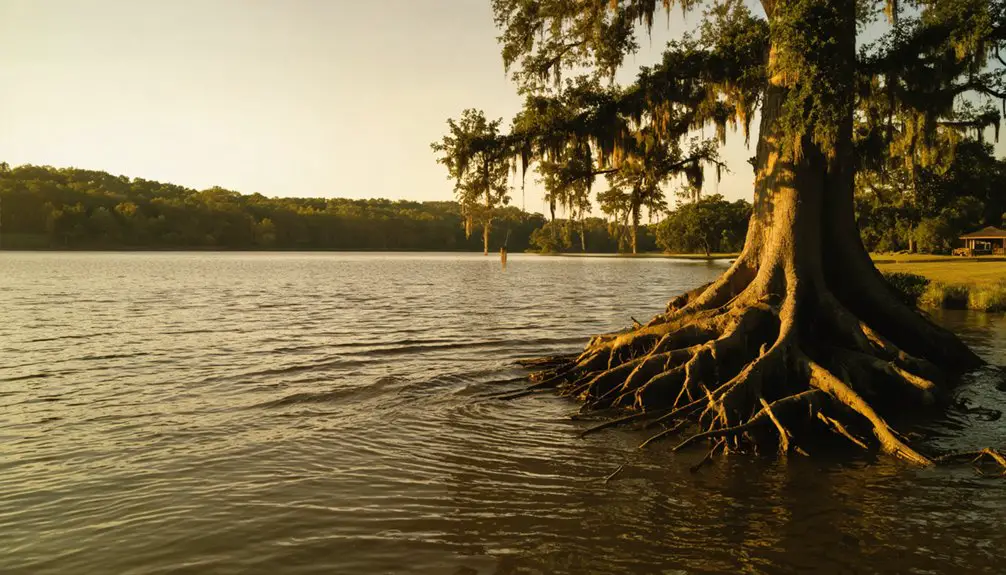
Beneath the calm waters of Watts Bar Lake lies the remarkable legacy of Rhea Springs’ healing waters and vibrant community life.
If you visit today, you’ll find a submerged history of a once-thriving town that centered around its renowned mineral springs, where people sought cures for various ailments.
The forgotten memories include a grand hotel, Methodist church, schoolhouse, and countless homes that now rest silently on the lake bottom.
While most physical structures were claimed by the waters in 1942, you can still find tangible connections to this lost community. A memorial in Spring City showcases marble and granite from the original buildings, while the old cemetery remains above water level.
Local historians continue documenting oral histories, ensuring that Rhea Springs’ story endures despite its watery fate.
What Remains Above the Waters
Today, scattered remnants of Rhea Springs peek through Watts Bar Lake’s surface, offering glimpses into the town’s submerged past. During low water levels, you’ll discover historical significance in the concrete foundations, water tower remnants, and stone blocks that once formed this vibrant community.
- Old schoolhouse foundations emerge when water levels drop
- Water tower base marks the grand hotel’s former location
- A hilltop cemetery overlooks the submerged town site
- Stone and marble pieces from original structures form a memorial in Spring City
- Seasonal exposure reveals paths and cleared areas near Rhea Springs Park
The lavish resort hotel once attracted visitors from across the United States who came to enjoy the town’s amenities. These remnants revealed tell a story of progress and sacrifice, as the TVA’s dam project forever changed this landscape.
While most of Rhea Springs sleeps beneath the water, these physical traces preserve its memory for future generations.
Tales From Former Residents
Through oral histories and documented accounts, former residents of Rhea Springs paint a vivid picture of daily life centered around the town’s famous healing waters.
You’ll hear tales of sulfur springs curing everything from liver ailments to yellow fever, with Native American healing traditions predating the town’s establishment.
The Methodist church, established in 1840, served as the heart of community gatherings.
Many resident reflections focus on the town’s vibrant social scene, where locals worked at the resort while visitors sought the spring’s healing properties.
Bustling with activity, Rhea Springs merged work and wellness as townspeople served tourists drawn to the medicinal waters.
Today, ghostly encounters pepper local folklore, as descendants like Pat Guffey preserve stories of what lies beneath Watts Bar Lake.
The community’s spirit lives on through these accounts, even as the physical town remains submerged, creating an underwater monument to a once-thriving health resort.
Legacy of a Lost Town
While the stories of former residents keep Rhea Springs’ memory alive, the physical remnants of this once-bustling health resort tell their own tale of loss and transformation.
The community legacy lives on through visible traces and cultural significance that you’ll find preserved both above and below Watts Bar Lake’s surface.
Situated along the Tennessee River bank, the town’s location contributed to its eventual fate when the valley was flooded.
- A memorial in Spring City, crafted from original marble columns and foundation stones, stands as a tribute to the town’s prominence.
- The old cemetery and water tank remain as silent witnesses to a thriving past.
- Submerged ruins of the hotel, school, and homes create an underwater time capsule.
- Archaeological exploration continues to uncover artifacts that document daily life.
- Local historians preserve the town’s memory through research and documentation, ensuring future generations understand Rhea Springs’ impact on regional history.
Historical Impact on Tennessee Valley
Before its inundation by the TVA, Rhea Springs wielded significant economic and cultural influence across the Tennessee Valley as a renowned 19th-century health resort.
Once a thriving Victorian health destination, Rhea Springs vanished beneath TVA waters, taking its healing mineral springs with it.
You’ll find its historical significance deeply rooted in the mineral spring’s reputation for healing properties, which drew visitors from across the region seeking cures for various ailments.
The economic transformation brought by TVA’s modernization efforts created lasting demographic shifts, as the community’s forced relocation scattered residents throughout Rhea County.
Environmental consequences of the Watts Bar Dam forever altered the region’s landscape, submerging not just buildings but an entire cultural heritage beneath Watts Bar Lake.
The social disruption exemplifies the modernization conflicts that characterized TVA’s development era, where progress came at the cost of destroying tight-knit communities and their cherished traditions.
Frequently Asked Questions
What Wildlife Now Inhabits the Underwater Ruins of Rhea Springs?
You’ll find a thriving underwater ecosystem where bass, catfish, and crappie swim through sunken ruins, while turtles, crayfish, and freshwater mussels make this ghost town wildlife’s new home.
How Deep Underwater Are the Remains of the Original Buildings?
You’ll find these buildings of historical significance resting 20-40 feet beneath the lake’s surface, making them accessible for underwater exploration while their concrete foundations remain visible near the shoreline.
Were Any Artifacts Recovered Before the Town Was Submerged?
Picture a town fading beneath rising waters. You won’t find much evidence of major artifact recovery, as TVA’s historical preservation efforts focused mainly on relocating buildings and residents, not collecting everyday items.
Did Any Residents Refuse to Leave During the TVA Flooding?
You won’t find historical accounts showing flood resistance from residents – available records indicate they cooperated with TVA’s relocation process after receiving official notices in 1936, moving before waters rose.
What Was the Average Water Temperature of the Mineral Springs?
While you’d find the mineral composition historically significant, precise spring temperatures weren’t documented, but based on regional data, you can estimate they averaged between 55-65°F, typical for non-thermal Tennessee springs.
References
- https://www.wdef.com/special-report-legend-rhea-spring/
- https://www.wdef.com/special-report-lost-towns-watts-bar-lake/
- https://www.tnmagazine.org/tennessees-underwater-ghost-towns/
- https://sharetngov.tnsosfiles.com/tsla/exhibits/tnresorts/aftermath.htm
- https://www.pinterest.com/pin/remembering-rhea-springs-part-11-additional-families–570831321518939509/
- https://en.wikipedia.org/wiki/Rhea_Springs
- https://digitaltennessee.tnsos.gov/exhibit/wish-you-were-here/waters/
- https://tennesseeencyclopedia.net/entries/rhea-county/
- https://dc.etsu.edu/cgi/viewcontent.cgi?article=2118&context=etd
- https://www.youtube.com/watch?v=_ylUFn9F12E
